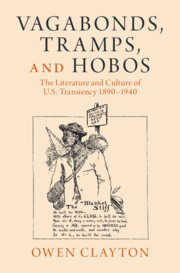Book contents
- Vagabonds, Tramps, and Hobos
- Cambridge Studies in American Literature and Culture
- Vagabonds, Tramps, and Hobos
- Copyright page
- Dedication
- Contents
- Figures
- Acknowledgements
- Part I Context
- Part II The Vagabond and the Tramp
- Part III The Hobo Transformed
- 5 Between Hobohemia and Academia: Nels Anderson’s Double Voice
- 6 ‘The Laureate of the Logging Camps’: Language, Food and Revolution in the Work of T-Bone Slim
- 7 ‘I’m a Hobo Myself Sometimes’: African-American Transiency in Black Vernacular Music
- Conclusion: The End of the Road? Transiency beyond the Hobo
- Notes
- Bibliography
- Index
- Recent books in this series (continued from page ii)
5 - Between Hobohemia and Academia: Nels Anderson’s Double Voice
from Part III - The Hobo Transformed
Published online by Cambridge University Press: 27 July 2023
- Vagabonds, Tramps, and Hobos
- Cambridge Studies in American Literature and Culture
- Vagabonds, Tramps, and Hobos
- Copyright page
- Dedication
- Contents
- Figures
- Acknowledgements
- Part I Context
- Part II The Vagabond and the Tramp
- Part III The Hobo Transformed
- 5 Between Hobohemia and Academia: Nels Anderson’s Double Voice
- 6 ‘The Laureate of the Logging Camps’: Language, Food and Revolution in the Work of T-Bone Slim
- 7 ‘I’m a Hobo Myself Sometimes’: African-American Transiency in Black Vernacular Music
- Conclusion: The End of the Road? Transiency beyond the Hobo
- Notes
- Bibliography
- Index
- Recent books in this series (continued from page ii)
Summary
Chapter Five turns to the figure of the hobo as constructed by Nels Anderson, a former hobo who became a member of the influential ‘Chicago School’ of sociology. It argues that Anderson’s early writing, in particular The Hobo (1923) and The Milk and Honey Route (1931), projects the hobo as a distinctively American figure, separate from the supposedly European tramp because of his commitment to hard work. I argue that The Milk and Honey Route is crucial to understanding Anderson’s The Hobo. Both books contain a distinctive double voice that not only speaks to their author’s position as a hobo-turned sociologist, but also expresses scepticism towards the project of sociology itself. In making this latter argument, the chapter pays attention to Anderson’s tone and language. Making use of literary close reading, I argue that his early style is distinguished by a voice that mixes different modes, including the sociological and autobiographical, in conflicting and paradoxical ways. While earlier scholars have noted Anderson’s ambiguous representation of hobos, this chapter demonstrates that he was equally ambiguous about the sociologists who studied them.
Keywords
- Type
- Chapter
- Information
- Vagabonds, Tramps, and HobosThe Literature and Culture of U.S. Transiency 1890–1940, pp. 139 - 166Publisher: Cambridge University PressPrint publication year: 2023

